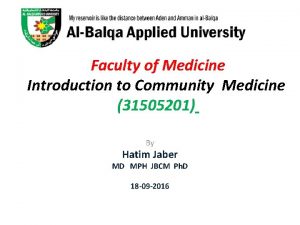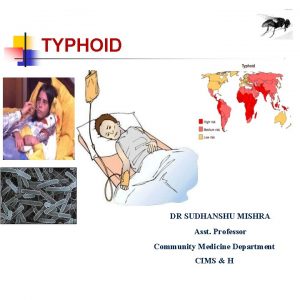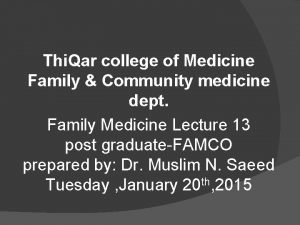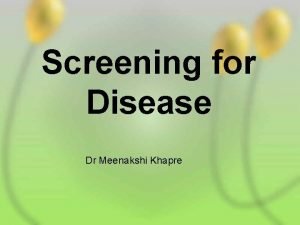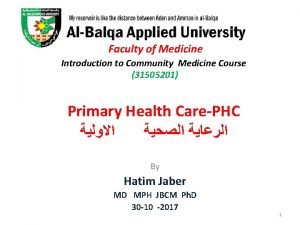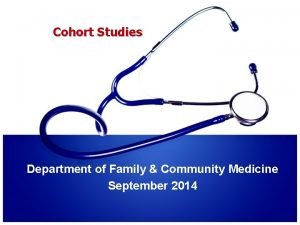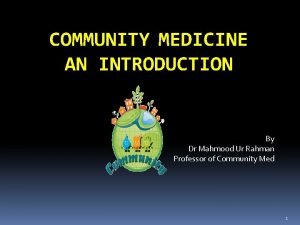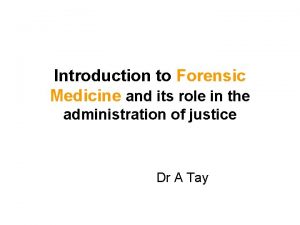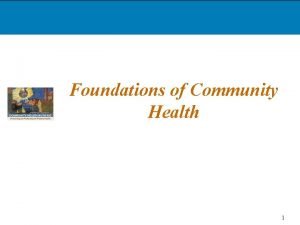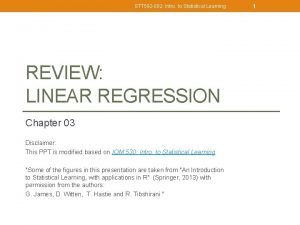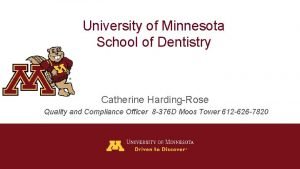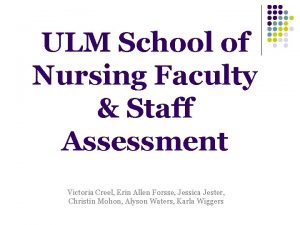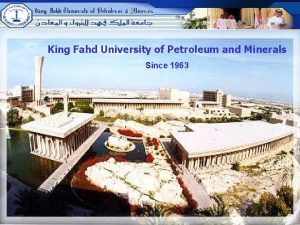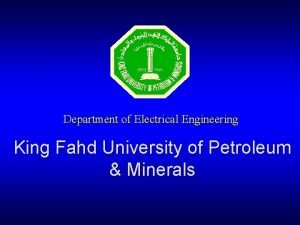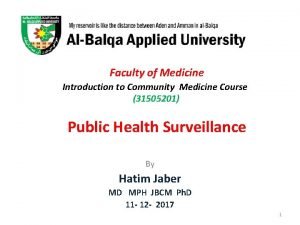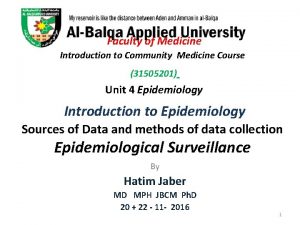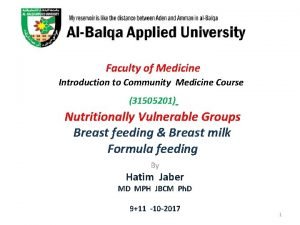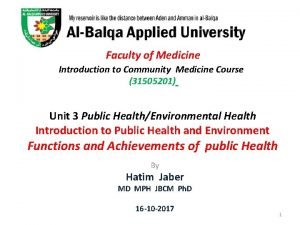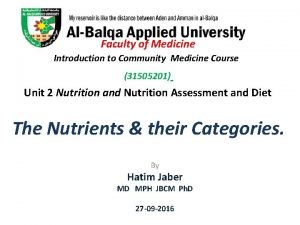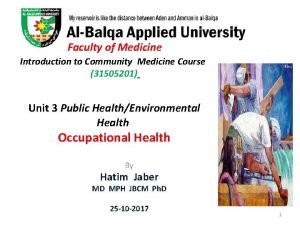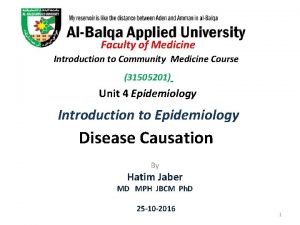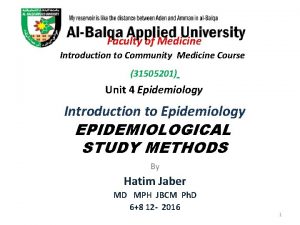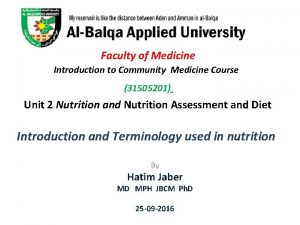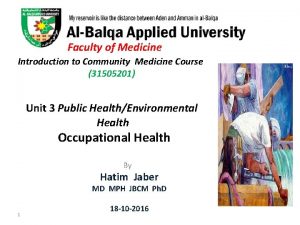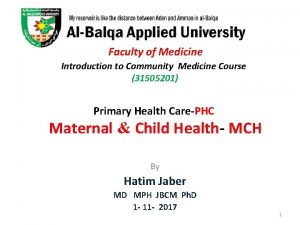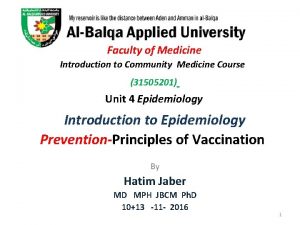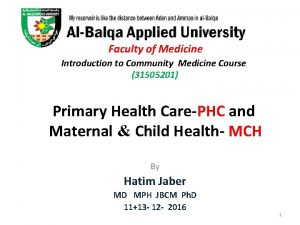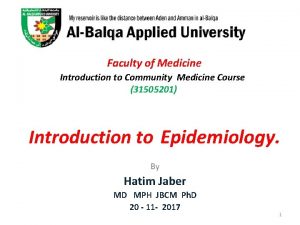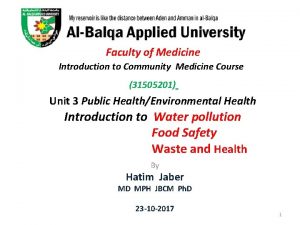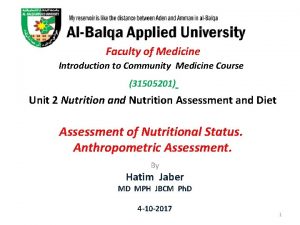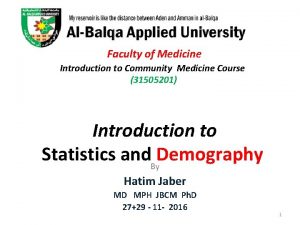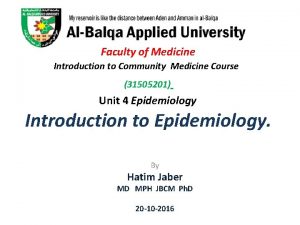Faculty of Medicine Introduction to Community Medicine Course

























































































- Slides: 89

Faculty of Medicine Introduction to Community Medicine Course (31505201) Unit 3 Public Health/Environmental Health Air Pollution By Hatim Jaber MD MPH JBCM Ph. D 18 -10 -2017 1


Introduction to course 31505201 Course Content • Week 1 Unit 1: Introduction to Health and Community Health • Week 2 Unit 2 Nutrition and Nutrition Assessment and Diet • Week 3 Unit 2 (cont. ) Nutrition and Nutrition Assessment and Diet • Week 4 Unit 2 (con. . ): Infant and Breast Milk Characteristics • Week 5 Unit 3: Public Health/Environmental Health • Week 6 Public Health/Environmental Health • Week 7 Unit 5: Epidemiology : Study design • • • Primary Health care Week 8 Unit 6: Demography, Data and Biostatics Week 9 Midterm assessment (Exams. )15 -11 -2017 Week 10 Unit 8 Public Health Surveillance Week 11 Unit 9: Prevention and Control of Diseases Week 12 Unit 10: Health Education and Communication Week 13 Unit 11: Screening Week 14 Unit 12: Health Administration and healthcare management Week 15 Unit 13: Health Research Week 16 Final assessment (Exams. ) 3

Introduction to Unit 3 Public Health and Environment 4 lectures 1. Introduction to Public Health and Environment-- 1610 -2017 2. Environment 1 - Air pollution— 18 -10 -2017 3. Environment 2 - Water Quality 23 -10 -2017 Environment 3 -Waste Management 4. Occupational Health -25 -10 -2017 4

Presentation outline Time Air Pollution : Definition and Health Impact Outdoor and Indoor Air Pollution 08: 15 to 08: 25 to 08: 40 Global Warming 08: 40 to 09: 00 Ozone Depletion 09: 00 to 09: 15 Temperature Inversion 09: 15 to 09: 30 Controlling Air Pollution 5

COMPONENTS OF ENVIRONMENT For descriptive purpose, environment has been divided into three components, all closely related : , air, • (i) Physical Water soil, housing, wastes, radiation, etc. • (ii) Biologic Plant and animal life including bacteria, viruses, insects, rodents and animals. • (iii) Social Customs, culture, habits, income, occupation, religion etc.

Environmental Health? Air Sunlight Food Noise Water Soil The study of how the environment affects your health. 7

Route #1: Inhalation: Breathing. When chemicals enter the body through this route of exposure, they can get stuck in the lungs and/or be taken up into the bloodstream. 8


The four types of Atmosphere • Troposphere: 8 -18 km, close to earth surface • Stratosphere: up to 50 km, OZONE - absorbs harmful ultraviolet radiation from sun • Mesosphere: > 50 km • Thermosphere and Exosphere= upper atmosphere 10

Man Made Environment (Socio-cultural) • Cultural OR man made environment : It includes 1)Industries, 2)Transport and communication, 3)Population, 4)Traditions, 5)Political situations etc. 11




Air Pollution : Definition and Health Impact 15

Air pollution and Ventilation Air pollution; is the introduction of chemicals, particulate matter, or biological material-- that cause harm discomfort to humans or other living organisms, or damages the natural environment, -- into the atmosphere. OR Chemicals added to the atmosphere by natural events or human activities in high enough concentrations to be harmful Ventilation : A process, whereby air is supplied and removed from an indoor space by natural or mechanical means. Why ventilation is needed indoors? To remove heat or moisture OR to reduce the 16 concentration of one OR more indoor pollutants.


Air pollution and your health – what are the facts? • The World Health Organization (WHO) has stated that “air pollution – both ambient [outdoor] and household [indoor] – is the biggest environmental risk to health, carrying responsibility for about one in every nine deaths annually. ” • WHO air quality model confirms that 80% of the world’s population lives in places where air quality levels exceed WHO limits*

Global Public Health Impact • With 23 per cent of global deaths (12. 6 million) linked to environmental factors, WHO estimates that air pollution is responsible for 9 million deaths every year. • Some 3 million deaths a year are linked to exposure to outdoor air pollution. • Indoor air pollution can be just as deadly. • Nearly 90% of air-pollution-related deaths occur in low- and middle-income countries, with nearly 2 out of 3 occurring in WHO’s South-East Asia and Western Pacific regions.

Invisible, Silent Killer

Atmosphere as a Resource • Atmospheric Composition – Nitrogen 78. 08% – Oxygen 20. 95% – Argon 0. 93% – Carbon dioxide 0. 04% • Ecosystem services – Blocks UV radiation – Moderates the climate – Redistributes water in the hydrologic cycle

Types and Sources of Air Pollutants • Two categories – Primary Air Pollutant • Harmful substance that is emitted directly into the atmosphere – Secondary Air Pollutant • Harmful substance formed in the atmosphere when a primary air pollutant reacts with substances normally found in the atmosphere or with other air pollutants

Major Air Pollutants


Top-ten gases in air pollution 1. Sulfur dioxide: 2. Carbon monoxide 3. Carbon dioxide: 4. Nitrogen oxides: 5. Volatile organic compounds (VOCs): 6. Particulates 7. Ozone: 8. Chlorofluorocarbons (CFCs): 9. Unburned hydrocarbons: 10. Lead and heavy metals:

Major Classes of Air Pollutants 1. 2. 3. 4. 5. 6. Particulate Material Nitrogen Oxides Sulfur Oxides Carbon Oxides Hydrocarbons Ozone

Particulate Material • Thousands of different solid or liquid particles suspended in air – Includes: soil particles, soot, lead, asbestos, sea salt, and sulfuric acid droplets • Dangerous for 2 reasons – May contain materials with toxic or carcinogenic effects – Extremely small particles can become lodged in lungs




Nitrogen and Sulfur Oxides • Nitrogen Oxides – Gases produced by the chemical interactions between atmospheric nitrogen and oxygen at high temperature – Problems • Greenhouse gases • Cause difficulty breathing • Sulfur Oxides – Gases produced by the chemical interactions between sulfur and oxygen – Causes acid precipitation

Carbon Oxides and Hydrocarbons • Carbon Oxides – Gases carbon monoxide (CO) and carbon dioxide (CO 2) – Greenhouse gases • Hydrocarbons – Diverse group of organic compounds that contain only hydrogen and carbon (ex: CH 4 - methane) – Some are related to photochemical smog and greenhouse gases


Ozone • Tropospheric Ozone – Man- made pollutant in the lower atmosphere – Secondary air pollutant – Component of photochemical smog • Stratospheric Ozone – Essential component that screens out UV radiation in the upper atmosphere – Man- made pollutants (ex: CFCs) can destroy it

Environmental Risk Factors and Health: • The evidence shows that environmental risk factors play a role in more than 80% of the diseases regularly reported by the World Health Organization. • Globally, nearly one quarter of all deaths and of the total disease burden can be attributed to the environment. 35

Effects of Air Pollution • Low level exposure – Irritates eyes – Causes inflammation of respiratory tract • Can develop into chronic respiratory diseases

Health Effects of Air Pollution 1. Sulfur Dioxide and Particulate material Irritate respiratory tract and impair ability of lungs to exchange gases 2. Nitrogen Dioxides Causes airway restriction 3. Carbon monoxide Binds with iron in blood hemoglobin Causes headache, fatigue, drowsiness, death 4. Ozone Causes burning eyes, coughing, and chest discomfort

Children and Air Pollution • Greater health threat to children than adults – Air pollution can restrict lung development – Children breath more often than adults • Children who live in high ozone areas are more likely to develop asthma

Air Pollution Around the World • Air quality is deteriorating rapidly in developing countries • Shenyang, China – Residents only see sunlight a few weeks each year • Developing countries have older cars – Still use leaded gasoline • 5 worst cities in world – Beijing, China; Mexico City, Mexico; Shanghai, China; Tehran, Iran; and Calcutta, India


Case-In-Point Air Pollution in Beijing and Mexico City • Beijing (left) • Mexico City (above)

Urban Air Pollution • Photochemical Smog (ex: Los Angeles below) – Brownish-orange haze formed by chemical reactions involving sunlight, nitrogen oxide, and hydrocarbons

43

Outdoor and Indoor Air Pollution 44

INDOOR AIR POLLUTION -Indoor air pollutants may be up to 100 times higher than outdoor levels. (Environmental protection agency). -Most people spend 90% of their time indoors. (American Lung Association) Dirty ventilation systems are a 50% contributor to sick building syndrome. (Healthy Buildings International).

INDOOR AIR POLLUTION -50% of all illnesses are either caused or aggravated by polluted indoor air. (American College of Allergists). -Legionnaire’s disease was spawned in air conditioning ducts. (ALA) -Indoor airpollution is the primary cause in as many as 50 million cases of occupational chronic respiratory disease each year. (World Health Organization).

What Causes Indoor Air Pollution? ? · Air tightness of buildings · Poorly designed air conditioning and ventilation systems · Indoor sources of pollution · Outdoor sources of pollution

What Causes Indoor Air Pollution? ? Air Tightness in Buildings Causes inadequate supply of fresh air, as a result, negative pressure develops, which causes: · Ground level pollutants, e. g. CO, Radon etc. to be drawn inside the buildings. · Release of odor (Bioaerosols) and other pollutants. · Pull outside polluted air from vents, cracks and openings and increase dust, pollen etc. · Causes “Sick Building Syndrome”.

What Causes Indoor Air Pollution? ? Poorly Designed Air Conditioning Systems Results into the production of fungi, molds and other sickness causing microbes. Problems produce following effects· Reduction in oxygen level of spaces. · Increase in CO 2 level. · Increase in temperature. · Increase in humidity · Increase in Bioaerosols and odor

How can I tell that indoor air is contaminated? Sniff the air. The nose is the best odor and gas detector, and a good particle detector as well, especially when first entering a contaminated environment.

Health Effects of Indoor Air Pollutants Health effects due to indoor air pollutants may be short- as well as long-term. Short-term problems include a stuffy, odorous environment and symptoms such as burning eyes, skin irritation, and headaches. Long-term health problems have a longer latency period or are chronic in nature. Health conditions involving some allergic reactions, including hypersensitivity pneumonitis, allergic rhinitis, and some types of asthma, are triggered by bioaerosols.

Control of Indoor Air Pollution Basic approaches to control indoor air pollution include 1. 2. 3. 4. 5. source control, source isolation, increased ventilation, dehumidification, the use of filters. Possible sources of contamination are eliminated in a source-control strategy. Examples include banning smoking in public buildings. Source-isolation strategy is used in situations where a source cannot be completely eliminated. For instance, copy machine areas, food service stations, and bathrooms are often separately vented outside buildings to avoid the recirculation of return air. Low humidity should be maintained inside a house to limit the growth of such bacteria. Indoor air pollution can be a very serious problem. You should be aware of the potential health hazards within your home, and you should also know how to effectively reduce the levels of air pollutants

What is sick building syndrome ? The feeling of illness among majority of occupants of a conditioned space is called “Sick Building Syndrome”. A variety of illness symptoms reported by occupants in sick buildings are – Headache, fatigue, irritation in eyes, nose and throat, shortness of breathe etc. Causes Inadequate ventilation insufficient supply of outside air; poor mixing; fluctuations in temperature & humidity;

54

Indoor Air Pollution - Radon

Radon is the second leading cause of lung cancer, following smoking. Radon is odorless, colorless, and tasteless. It is a naturally occurring radioactive gas resulting from the decay of radium, itself a decay product of uranium. Radon is a radioactive gas that comes from the decay of uranium in the Earth. It comes up through cracks in the ground and can get into your basement. It can accumulate in the basement up to levels which can cause lung cancer. Smokers are at an especially high risk of getting lung cancer from radon.



Outdoor Air Pollution Global warming-Climate Change Ozone Depletion Temperature Inversion 59

Sources of Outdoor Air Pollution • Two main sources – Transportation – Industry • Intentional forest fires is also high

What is Climate Change? n Global warming and climate change are terms for the observed century-scale rise in the average temperature of the Earth's climate system and its related effects n Climate is the average weather at a given point and time of year, over a long period (typically 30 years). n We expect the weather to change a lot from day to day, but we expect the climate to remain relatively constant. n If the climate doesn’t remain constant, we call it climate change.

Global Warming “Climate changes” 62

What cause the temperature of the atmosphere to go up? • There are many possible mechanisms that can cause the warming of the atmosphere, for example: – Natural variation – the climate becomes warmer by internal chaotic dynamics of the earth-atmosphere system (that is, no external influence). – Solar activity – either direct increase of solar energy output or indirect “trigger” mechanisms due to solar activity (though nobody knows how) may cause the surface temperature to go up. – Greenhouse effect – increasing “greenhouse” gases such as CO 2, CH 4, NO, CFC, …etc. (actually H 2 O is very efficient, too, but at present it is assumed to be in steady state). • The last one is presently thought to be the most likely cause of the global warming. 63

Earth’s Atmospheric Gases Nitrogen (N 2) Oxygen (O 2) Non. Greenhouse Gases 99% Water (H 2 O) Carbon Dioxide (CO 2) Methane (CH 4) Greenhouse Gases 1%

Greenhouse gases • The greenhouse effect is the process by which absorption and emission of infrared radiation by gases in planet's atmosphere warm its lower atmosphere and surface. 65

Greenhouse gases • Greenhouse gases are a group of compounds that are able to trap heat (long wave radiation) in the atmosphere, keeping the Earth's surface warmer than it would be if they were not present. • These gases are the fundamental cause of the greenhouse effect. • Increases in the amount of greenhouse gases in the atmosphere enhances the greenhouse effect which is creating global warming and consequently climate change. 66


• Increases in the amount of greenhouse gases in the atmosphere enhances the greenhouse effect which is • creating global warming and • consequently climate change. 68

The consequences of global warming phenomenon are: 1. Extreme heat: 2. Natural disasters 3. Poor air quality: 4. Allergens and other nuisances: 5. Spreading diseases: 69

Possible impacts of climate change due to projected changes in extreme weather and climate events

Ozone Depletion 71

Ozone Depletion in Stratosphere • Ozone Protects earth from UV radiation – Part of the electromagnetic spectrum with wavelengths just shorter than visible light

Ozone Depletion in Stratosphere • Ozone thinning/hole – First identified in 1985 over Antarctica • Caused by – human-produced bromine and chlorine containing chemicals – Ex: CFCs

Effects of Ozone Depletion • Higher levels of UVradiation hitting the earth – Eye cataracts – Skin cancer (right) – Weakened immunity • May disrupt ecosystems • May damage crops and forests

To summarize the health effects of exposure to UVR as a result of Ozone depletion • 1. Skin cancer: Exposure to ultraviolet rays poses an increased risk of developing several types of skin cancers, including malignant melanoma, basal and squamous cell carcinoma. • 2. Eye damage: Direct exposure to UV radiations can result in photo-keratitis (snow blindness), and cataracts. • 3. Immune system damage: Effects of UV rays include impairment of the immune system. Increased exposure to UV rays weakens the response of the immune system. • 4. Accelerated aging of skin: Constant exposure to UV radiation cause photo allergy, which results in the outbreak of rash in fair-skinned people. • 5. Other effects: Ozone chemicals can cause difficulty in breathing, chest pain, throat irritation, and impede lung functioning. 75

Recovery of Ozone Layer • Montreal Protocol (1987) – Reduction of CFCs – Started using HCFCs (greenhouse gas) • Phase out of all ozone destroying chemicals is underway globally • Satellite pictures in 2000 indicated that ozone layer was recovering • Full recovery will not occur until 2050


Acid Deposition • Sulfur dioxide and nitrogen dioxide emissions react with water vapor in the atmosphere and form acids that return to the surface as either dry or wet deposition • p. H scale

How Acid Deposition Develops

Acid Deposition and Forest Decline

Effects of Acid Deposition • Declining Aquatic Animal Populations • Thin-shelled eggs prevent bird reproduction – Because calcium is unavailable in acidic soil • Forest decline – Ex: Black forest in Germany (50% is destroyed)

Temperature Inversion 82

Temperature Inversion • A temperature inversion is when a layer of warmer air covers the colder air at ground level. 6

All Over Town

Lack of heavy cloud cover Signs of a surface inversion in the early morning Windless or light variable wind Ground Fog Frost (or dew)

Controlling Air Pollution


What can I do to help reduce air pollution? • • • Save energy Save water when you can Cut the car Cut out garden bonfires Never burn household waste Garden organically Cut the chemicals Use water-based paints and glues: Reduce, reuse, and recycle Don't smoke

• https: //www. youtube. com/watch? v=Tds 3 k 97 a. Azo
 Introduction to community medicine
Introduction to community medicine Introduction to community medicine
Introduction to community medicine Hubert kairuki memorial university faculty of medicine
Hubert kairuki memorial university faculty of medicine Semmelweis university faculty of medicine
Semmelweis university faculty of medicine Faculty of medicine nursing and health sciences
Faculty of medicine nursing and health sciences King abdulaziz university faculty of medicine
King abdulaziz university faculty of medicine Semmelweis university faculty of medicine
Semmelweis university faculty of medicine Faculty of veterinary medicine cairo university logo
Faculty of veterinary medicine cairo university logo Hacettepe university faculty of medicine
Hacettepe university faculty of medicine Dorsocranially
Dorsocranially Semmelweis university faculty of medicine
Semmelweis university faculty of medicine Mcgill medicine supporting documents
Mcgill medicine supporting documents Faculty of veterinary medicine cairo university
Faculty of veterinary medicine cairo university Pubh4401
Pubh4401 Emory clinic - school of medicine faculty
Emory clinic - school of medicine faculty Cairo university faculty of veterinary medicine
Cairo university faculty of veterinary medicine Faculty introduction speech
Faculty introduction speech Cut brick lengthwise
Cut brick lengthwise Course title and course number
Course title and course number Course interne moyenne externe
Course interne moyenne externe Typhoid medicine course
Typhoid medicine course Lead time in community medicine
Lead time in community medicine Types of family in community medicine
Types of family in community medicine Concept of lead time
Concept of lead time Objectives of school health programme
Objectives of school health programme Elements of primary health care
Elements of primary health care Cohort study community medicine
Cohort study community medicine Duke family medicine and community health
Duke family medicine and community health Seqs community medicine
Seqs community medicine Plan together in community mobilization
Plan together in community mobilization Introduction to banking course
Introduction to banking course Imbe introduction course v2
Imbe introduction course v2 Software engineering 1 course outline
Software engineering 1 course outline Ron had a course introduction
Ron had a course introduction Cleft sentences
Cleft sentences Awe aldermaston
Awe aldermaston Introduction to forensic medicine
Introduction to forensic medicine Introduction of community policing
Introduction of community policing Community pharmacy management
Community pharmacy management Characteristics of community health nursing
Characteristics of community health nursing An introduction to community asset mapping
An introduction to community asset mapping An introduction to community asset mapping
An introduction to community asset mapping Introduction to community pharmacy
Introduction to community pharmacy University of split faculty of maritime studies
University of split faculty of maritime studies Bridgeport engineering department
Bridgeport engineering department Bridgeport university computer science
Bridgeport university computer science Alamo colleges salary schedule
Alamo colleges salary schedule Hahnville high school faculty
Hahnville high school faculty Importance of faculty in higher education
Importance of faculty in higher education Http://www-bcf.usc.edu/~gareth/isl/advertising.csv
Http://www-bcf.usc.edu/~gareth/isl/advertising.csv Penn state neurosurgery
Penn state neurosurgery Mercy faculty forward
Mercy faculty forward Lee kong chian faculty of engineering and science
Lee kong chian faculty of engineering and science Carelli kutztown
Carelli kutztown Fsu cs faculty
Fsu cs faculty Mendel university faculty of business and economics
Mendel university faculty of business and economics Electrical engineering umd
Electrical engineering umd Factors influencing faculty staff relationship
Factors influencing faculty staff relationship Nit calicut chemistry department
Nit calicut chemistry department Czech technical university in prague civil engineering
Czech technical university in prague civil engineering Ecu faculty manual
Ecu faculty manual Benha faculty of engineering
Benha faculty of engineering Singularity executive program
Singularity executive program Faculty of law maastricht
Faculty of law maastricht Medical faculty in novi sad dean
Medical faculty in novi sad dean Umn faculty dental clinic
Umn faculty dental clinic Sjsu faculty affairs
Sjsu faculty affairs Unlv faculty senate
Unlv faculty senate Ulm nursing faculty
Ulm nursing faculty Ucl university computer science
Ucl university computer science Elibrary symbiosis
Elibrary symbiosis Faculty model of training
Faculty model of training Https://faculty.washington.edu/chudler/stm0.html
Https://faculty.washington.edu/chudler/stm0.html Faculty kutztown carelli
Faculty kutztown carelli Student faculty ratio for nba
Student faculty ratio for nba Kfupm clinic
Kfupm clinic Masaryk university medical faculty
Masaryk university medical faculty Faculty model of training
Faculty model of training Jey veerasamy
Jey veerasamy Fulbright faculty development program
Fulbright faculty development program Feup university of porto
Feup university of porto Faculty of organizational sciences
Faculty of organizational sciences Charles university humanities
Charles university humanities Electrotechnical faculty belgrade
Electrotechnical faculty belgrade University of debrecen faculty of economics and business
University of debrecen faculty of economics and business Dmse
Dmse Kfupm ee faculty
Kfupm ee faculty Faculty model of training
Faculty model of training Bu questrom tools
Bu questrom tools Faculty model of training
Faculty model of training

